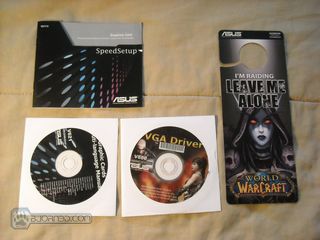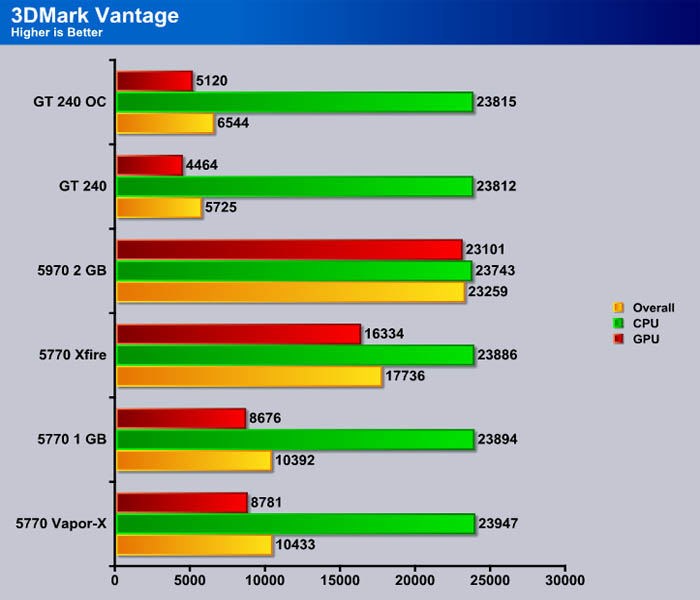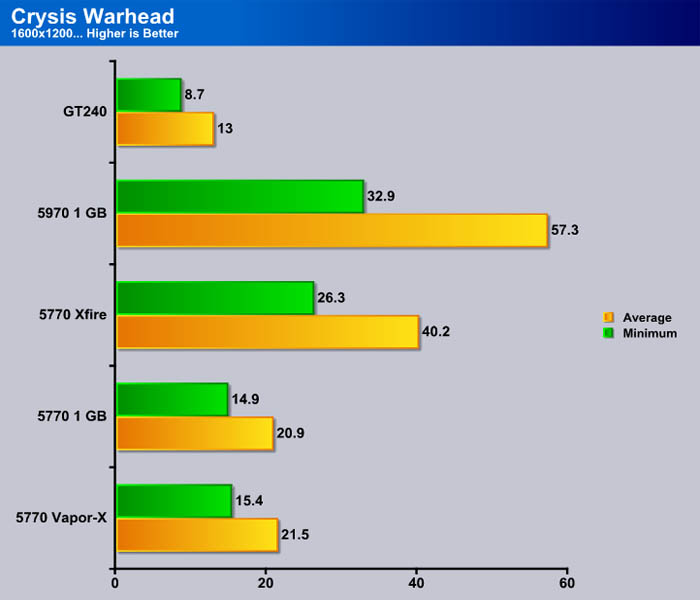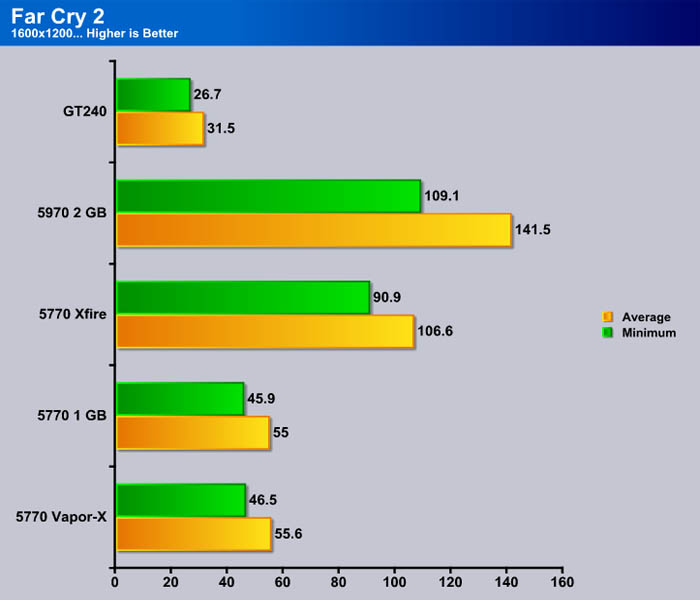When you want a gaming card, but don’t have a lot in the budget, or a lack of power then your options are limited. The GT240 really fits this spot, but Asus has decided to improve on its design by including GDDR5. This significantly increases the cards bandwidth, making it much more powerful than a regular GT240.
Introduction
Are you in the market for a lower power card that is still able to play all of the latest games? You may want to take notice at Nvidia’s GT240 then. This card requires no outside power connectors yet delivers enough power to play the latest games. While the settings might not be maxed like we see on many of the highest end cards, it doesn’t require a nuclear power plant to run it either. Many people are also just looking for a card that will comfortably play their games without leaving a gigantic hole in their pocket, and in the current economic climate I can’t blame them.
However this is not just your average GT240. Asus has made the decision to include 1 GB of GDDR5 to significantly speed up this GT240 over one that uses the older GDDR3. The extra RAM will also help the card handle games at higher resolutions, so your games won’t end up looking like something on the N64. Lets take a closer look at exactly what is under the hood of this card.

Features
Asus has packed this card with some of their own features.The most notable of which is Smart Doctor. This is an overclocking utility that you can use to easily overclock your GPU without having to look for third party software. Asus also touts its GPU Guard which should help strengthen the card so it has a lower chance of being bused in half.
Specifications
| Feature/Specification | HD 5770 | GT240 | 5750 |
|---|---|---|---|
| # Of Shaders | 800 | 96 | 720 |
| Core Clock |
850 |
550 | 700 |
| Texture Units | 40 | 32 | 36 |
| Raster Operators |
16 | 8 | 16 |
| Memory Interface (bit) |
128 |
128 | 128 |
| Memory Size | 1 GB | 1 GB | 512 MB/1 GB |
| Memory Type | GDDR 5 | GDDR 5 | GDDR 5 |
| Memory Clock (effective) |
4800 | 3400 | 4600 |
On paper the GT240 shouldn’t stand half a chance, but the shaders on Nvidia cards are clocked higher. However the 240 is seriously lacking ROPs. Nvidia could have had a killer card on their hands if they would have added a few more ROPs, and kept the same price point.
Pictures & Impressions
Asus has decided to seek endorsement from the folks at Blizzard for this card. On the front is a World of Warcraft theme along with a 14 day trial being bundled with the graphics card. This is kind of pointless since you can get a 14 day free trial online. We would have rather saw the full game bundled in with the card.
When we open the box we are greeted with a neatly wrapped card. There are a few cardboard cutouts too keep the card from moving around in the box which allows the card to be safer on transport. The card is also wrapped in a anti static bag to keep it from getting zapped.
Here we have the bundled accessories. The disk on the left is the Asus manual while the other disk includes the Drivers and such. Asus threw in a World of Warcraft door hanger. If you are a WoW fan you will probably find this useful.
The card is pretty basic itself. The cooler is one that Asus has previously used on its mid range GPU’s for a couple of generations now. There is no fan control, so the fan will be running at full speed the whole time, but it is a large fan so it shouldn’t be too loud. The rest of the PCB looks pretty bare.
This cooler is just enough to be considered a dual slot cooler. This should be way more than enough for this card, which doesn’t produce a whole lot of heat. We also get a clear look at the profile of the back of the card. It doesn’t look like Asus did any reinforcing to me unless they consider the more beefier heat sink as strengthening the card.
Asus has decided to include a HDMI, VGA and DVI connector instead of the usual dual DVI route. This card is in the price range of someone looking for a slightly higher end card for an HTPC, so it makes sense why they put a HDMI port on the card. We still would have rather seen a dual DVI setup, but we suppose anyone with a VGA monitor might be confused if they are new to computers.
Methodology
To test this card, we did a fresh load of Windows 7 Ultimate 64 bit and applied all the patches and updates for the OS, then we updated all the motherboard drivers and made sure that we had the latest 9.12 Catalyst drivers. We didn’t install any video drivers on the test rig at first, we just installed the basics and then cloned the hard drive using Acronis. That way when we switch from the ATI GPU to the Nvidia GPU we can have a fresh load with no old drivers hanging around to bugger up our benchmark numbers.
We ran each test 3 times and averaged the results, the average of those results are reported here. The one exception to the 3 run rule is Stalker, this test is just long so all of the individual tests were averaged together. Below is a detailed list of the components used during testing.
| Test Rig | |
| Case | Cooler Master HAF 932 |
| CPU | Intel i7 920 @ 3.9 Ghz |
| Motherboard | Asus P6X58D |
| Ram | (6x2GB) DDR3 @ 1560 9-9-9-22 |
| CPU Cooler | D-Tek Fuzion |
| Hard Drives | Corsair P64 Western Digital 750 GB |
| Optical | LiteOn DVDR |
| GPU’s Tested |
Sapphire HD 5970 |
| Testing PSU | Corsair HX1000 Watt |
Synthetic Benchmarks & Games
| Synthetic Benchmarks & Games | |
| 3DMark 06 | |
| 3DMark Vantage | |
| Crysis | |
| Crysis Warhead | |
| Far Cry 2 | |
| Hawx | |
| Resident Evil 5 | |
| Grand Theft Auto 4 | |
Overclocking
To overclock the GPU we first started with MSI Afterburner. We used Afterburner to slowly raise the clocks by 10 MHz at a time on the card until it became unstable. We then back the card down until it becomes 100% stable. We do this for both the GPU core and the memory. In the case of Nvidia cards we leave the Core clock and Shader clock synchronized.
We achieved a pretty respectable result here. The higher memory clock should help increase the bandwidth of the card even more, so those 96 stream processors can get some use. The higher core clock will ensure that the card is able to render the game even faster.
We see a pretty sizable difference here, which should propel the GT240 much closer in performance to the 5770. The levels we see here should put this card between a 9600 GT and a 9800 GT.
3DMARK06 V. 1.1.0
3DMark06 developed by Futuremark, is a synthetic benchmark used for universal testing of all graphics solutions. 3DMark06 features HDR rendering, complex HDR post processing, dynamic soft shadows for all objects, water shader with HDR refraction, HDR reflection, depth fog and Gerstner wave functions, realistic sky model with cloud blending, and approximately 5.4 million triangles and 8.8 million vertices; to name just a few. The measurement unit “3DMark” is intended to give a normalized mean for comparing different GPU/VPUs. It has been accepted as both a standard and a mandatory benchmark throughout the gaming world for measuring performance.
The GT240 gets off to a sort of rocky start. It was expected that it wouldn’t be able to reach the 5770, but it falls on its face here.
3DMark Vantage
For complete information on 3DMark Vantage Please follow this Link:
www.futuremark.com/benchmarks/3dmarkvantage/features/
The newest video benchmark from the gang at Futuremark. This utility is still a synthetic benchmark, but one that more closely reflects real world gaming performance. While it is not a perfect replacement for actual game benchmarks, it has its uses. We tested our cards at the ‘Performance’ setting.
Currently, there is a lot of controversy surrounding NVIDIA’s use of a PhysX driver for its 9800 GTX and GTX 200 series cards, thereby putting the ATI brand at a disadvantage. Whereby installing the PyhsX driver, 3DMark Vantage uses the GPU to perform PhysX calculations during a CPU test, and this is where things get a bit gray. If you look at the Driver Approval Policy for 3DMark Vantage it states; “Based on the specification and design of the CPU tests, GPU make, type or driver version may not have a significant effect on the results of either of the CPU tests as indicated in Section 7.3 of the 3DMark Vantage specification and white paper.” Did NVIDIA cheat by having the GPU handle the PhysX calculations or are they perfectly within their right since they own Ageia and all their IP? I think this point will quickly become moot once Futuremark releases an update to the test.
The GT240 manages a little better here. The scores are roughly half of what the 5770 is getting, so if we see more than half of the FPS in games then it should be doing quite well.
Crysis v. 1.21
Crysis is the most highly anticipated game to hit the market in the last several years. Crysis is based on the CryENGINE™ 2 developed by Crytek. The CryENGINE™ 2 offers real time editing, bump mapping, dynamic lights, network system, integrated physics system, shaders, shadows, and a dynamic music system, just to name a few of the state-of-the-art features that are incorporated into Crysis. As one might expect with this number of features, the game is extremely demanding of system resources, especially the GPU. We expect Crysis to be a primary gaming benchmark for many years to come.


We see here that the GT240 is once again in last place. However it did manage to be only about 11 frames behind the 5770, which is a much more powerful card.
CRYSIS WARHEAD
Crysis Warhead is the much anticipated sequel of Crysis, featuring an updated CryENGINE™ 2 with better optimization. It was one of the most anticipated titles of 2008.

The GT240 puts up a respectable 15.7 FPS average. This is pretty good considering the game is using the absolute maximum settings.
The GT240 is closer to the 5770 in the Warhead test than the original Crysis test. Again the card puts up some respectable numbers.
Far Cry 2
Far Cry 2, released in October 2008 by Ubisoft, was one of the most anticipated titles of the year. It’s an engaging state-of-the-art First Person Shooter set in an un-named African country. Caught between two rival factions, you’re sent to take out “The Jackal”. Far Cry2 ships with a full featured benchmark utility and it is one of the most well designed, well thought out game benchmarks we’ve ever seen. One big difference between this benchmark and others is that it leaves the game’s AI (Artificial Intelligence) running while the benchmark is being performed.

The Settings we use for benchmarking FarCry 2
The GT240 manages to just hold onto a playable frame rate. Not to shabby since the game is maxed.
Even with a resolution increase the GT240 still manages to hold its own, and climb above the magical 30 average FPS.
HawX
The story begins in the year 2012. As the era of the nation–state draws quickly to a close, the rules of warfare evolve even more rapidly. More and more nations become increasingly dependent on private military companies (PMCs), elite mercenaries with a lax view of the law. The Reykjavik Accords further legitimize their existence by authorizing their right to serve in every aspect of military operations. While the benefits of such PMCs are apparent, growing concerns surrounding giving them too much power begin to mount.
Tom Clancy‘s HAWX is the first air combat game set in the world–renowned Tom Clancy‘s video game universe. Cutting–edge technology, devastating firepower, and intense dogfights bestow this new title a deserving place in the prestigious Tom Clancy franchise. Soon, flying at Mach 3 becomes a right, not a privilege.

We have not seen a card in awhile that isn’t able to cut through Hawx like a hot knife through butter. The GT240 is no exception.
Even with the resolution increase the GT240 blazes through Hawx.
Resident Evil 5
Resident Evil 5 is the latest addition to the popular Resident Evil franchise. Set in Africa, you play as Chris Redfeild who is part of the Bio-terrorism Security Assessment Alliance (BSAA). You are sent to capture Ricardo Irving who is trying to bring a bio-organic weapon to the black market. However you quickly unravel something bigger…
The settings we used in Resident Evil 5
The GT240 is able to play Resident Evil 5 quite well at this resolution despite the game being maxed.
Even with the resolution increase the GT240 is able to handle its own here.
Grand Theft Auto 4
Grand Theft Auto 4 is the latest edition to the GTA franchise. The game takes you back to Liberty to play as Niko Bellic. Niko has come from an unnamed European country to “live the dream” with his cousin. He soon finds out that his cousin has been lying to him, and he must do odd jobs for big name criminals as well as high ranking officials just to stay alive.
The settings we used in GTA4
The GT240 is quite close to the 5770 here. In our experience with GTA 4 you don’t see much of a performance difference even when comparing to the higher end cards.
With the resolution increase, the game is still easily playable. The 5970 and 5770 Xfire gain a lot on the other cards by staying in the same relative area as they did at the lower resolution.
Conclusion
The Asus GT240 1 GB GDDR5 is a card that fits excellently into its own little part of the market. The card does not use a lot of power at all compared to how much performance the card can put out. It was not that long ago when we had cards with similar performance that required an external power connector. While it may not be on par with cards like the 5770, it still packs enough of a punch to easily play any game out there, and some of the more recent ones maxed.
The cooler on this card may be a tad bit larger than the one you may find on other cards, but if it will fit in your case you can be sure that this card will easily run cooler than a normal GT240. This can improve your overclocking potential as well as increase the cards life too. Asus choice of using GDDR5 was an excellent one. This greatly increases the bandwidth of the card which will improve its performance considerably. All in all, the Asus GT240 will certainly serve your casual gaming needs for years to come.
| OUR VERDICT: Asus GT240 |
||||||||||||||||||
|
||||||||||||||||||
|
Summary: The Asus GT240 1 GB GDDR5 graphics card fits the bill nicely if you are a casual gamer. The card does not need outside power, so you probably won’t be needing a new power supply or at least not a beefy one. The card can easily play any game out there. Maybe not maxed, but high enough so you can enjoy the game. |
 Bjorn3D.com Bjorn3d.com – Satisfying Your Daily Tech Cravings Since 1996
Bjorn3D.com Bjorn3d.com – Satisfying Your Daily Tech Cravings Since 1996




































